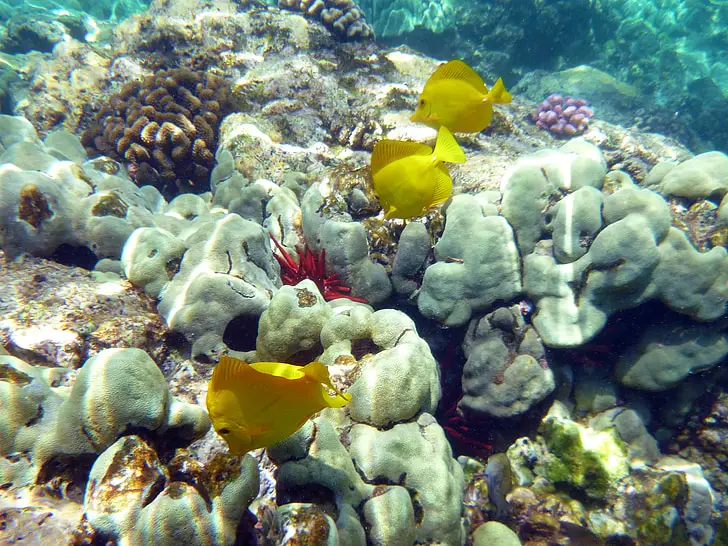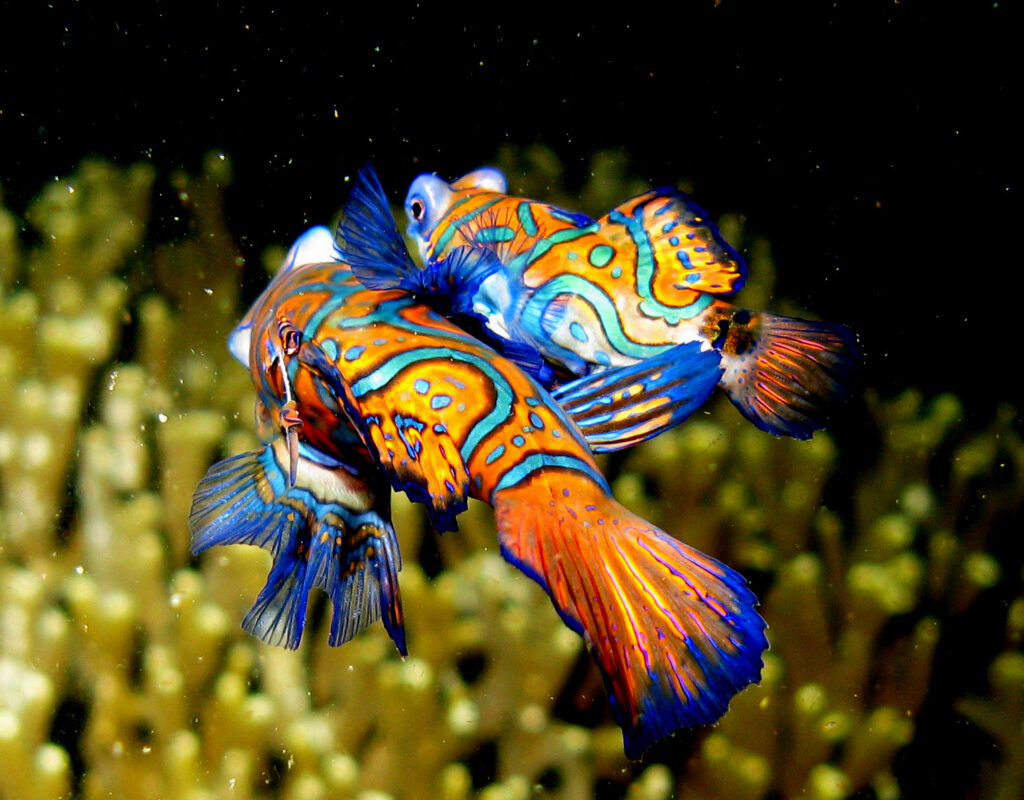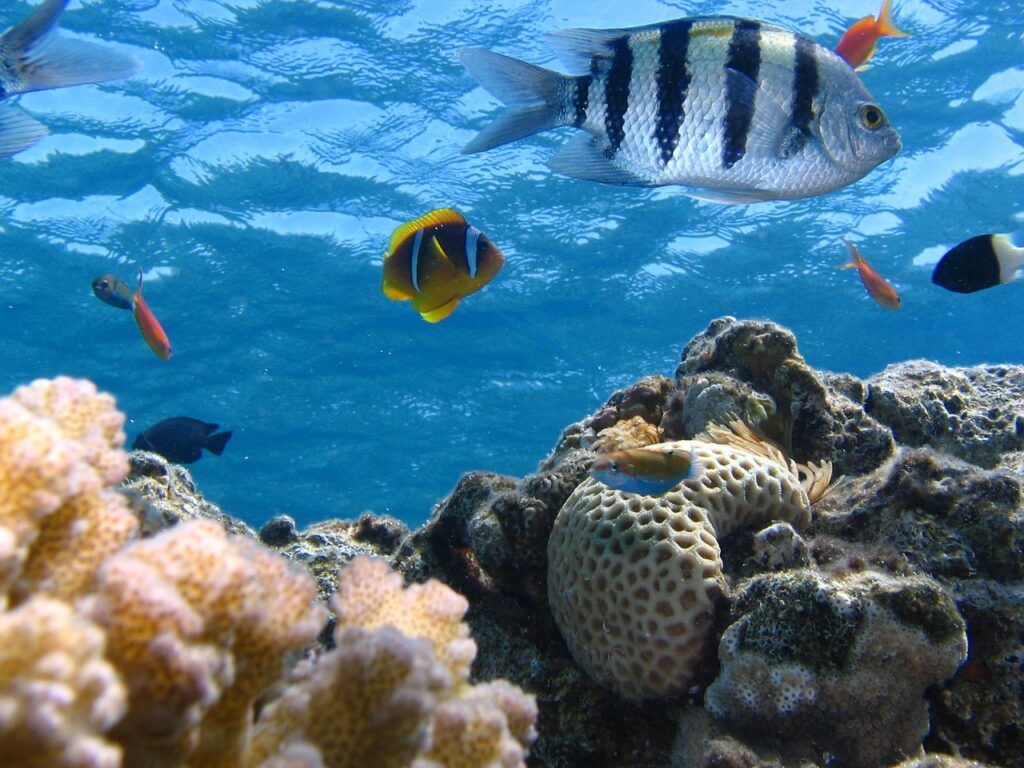Imagine snorkeling in crystal-clear Hawaiian water. Suddenly, a flash of sunshine streaks past – it’s a school of yellow tangs! These iconic fish, called lau’ipala in Hawaiian, are like living jewels of the reef. They look a bit like squished lemons with fins!
Yellow tangs are the underwater gardeners munching on algae to keep the reefs healthy. Their bright color, funny shape, and super important job make them superstars of the Hawaiian Islands. But there’s more to these fish than meets the eye.
They can change color at night, talk to each other with squeaks, and even have a secret weapon hidden in their tails!
Yellow Fish in Hawaiian Reef Ecosystems
Yellow fish are more than just a splash of color in Hawaiian waters – they’re like superheroes of the reef! Each species plays its own part in keeping the underwater world healthy and balanced. Take the yellow tang, a member of the Surgeonfish family. These guys are found all over Hawaiian reefs and have some seriously important jobs.
Think of a reef like a giant underwater city. Yellow tangs are the landscape crew! They nibble away at algae, which can overgrow and smother the coral if left unchecked. It’s like keeping weeds out of a garden. Did you know a single yellow tang can munch through a patch of algae the size of a tennis court daily? That’s a lot of salad!
Plus, yellow fish are tasty snacks for bigger predators like sharks and groupers. This keeps the populations of different species in balance, so no one group gets too powerful. A healthy reef needs yellow fish, and that means Hawaii needs them, too! Healthy reefs mean more fish for people to eat, cleaner water, and beautiful places for tourists to explore.
Common Yellow Fish Species in Hawaii
Hawaii’s reefs are a rainbow of fish colors, but yellow stands out! The most famous is the yellow tang (Zebrasoma flavescens). This sunny superstar is a member of the surgeonfish family, and you can spot it by its bright color and the sharp white spine near its tail (that’s the “surgeon” part of its name!).
But the yellow tang isn’t alone. Here’s a quick look at some other yellow beauties you might find while snorkeling:
|
Common Name |
Scientific Name |
Family |
Fun Fact |
|
Yellow Tang |
Zebrasoma flavescens |
Surgeonfish |
Changes color at night! |
|
Lemonpeel Angelfish |
Centropyge flavissima |
Angelfish |
Has a bright blue eye spot |
|
Yellowtail Coris |
Coris gaimard |
Wrasse |
Can bury itself in the sand to hide |
Note: Fish size is approximate for adults
Where to Find Them: Yellow tangs and their friends love the coral reefs around the Hawaiian Islands. They like shallow water (down to about 100 feet), where they can find lots of yummy algae to eat!
Yellow Tang: A Closer Look
Scientific Profile of Zebrasoma flavescens (Yellow Tang)
Classification:
- Kingdom: Animalia
- Phylum: Chordata (animals with a backbone)
- Class: Actinopterygii (ray-finned fishes)
- Order: Perciformes (a huge group, including perch, bass, etc.)
- Family: Acanthuridae (surgeonfishes)
- Genus: Zebrasoma
- Species: Z. flavescens
Yellow tangs belong to the diverse Animalia kingdom and possess the defining characteristics of a chordate—a backbone and spinal cord. As ray-finned fish, their fins are supported by bony rays, providing agility in their reef environment. They belong to the large Perciformes order, home to many familiar food fish. Their specific family, Acanthuridae, is known for the sharp spines that give surgeonfish their name.
Appearance:
- Color: Their vibrant yellow hue makes them instantly recognizable. This coloration warns potential predators, as many brightly colored marine animals are toxic or have a defense mechanism. Interestingly, they can temporarily change to a paler shade for camouflage at night or when feeling threatened.
- Shape: Their bodies are laterally compressed, ideal for slipping through reef crevices. This oval shape and powerful fins make them surprisingly fast for their size.
- Size: Adults average 7-9 inches but can reach up to 8 inches.
- Distinguishing Features: The white, scalpel-like spine on each side of the tail is a hallmark of surgeonfishes. It’s both a defensive weapon and a tool for establishing dominance within their groups.
Environmental Significance of Yellow Fish
Yellow fish, especially the famous yellow tang (Zebrasoma flavescens), are more than just a pretty face. They’re ecosystem engineers, keeping Hawaii’s coral reefs healthy and beautiful. Here’s how:
- The Algae Wars:Picture a coral reef as a giant, colorful city. Algae is like weeds that can take over if left unchecked. Yellow tangs are the underwater gardeners, nibbling away the algae before it can smother the corals. This keeps everything in balance.
- Part of the Food Web:Yellow tangs aren’t just eaters, they’re food too! Being a tasty snack for larger fish keeps populations balanced. No one species gets too numerous, which is important for a healthy ecosystem.
- Resilient Reefs:Healthy reefs are strong reefs. They can better withstand threats like storms, warming waters, and pollution. By keeping reefs clean, yellow tangs help them survive, which benefits everything living there…including people!
The Bigger Picture
Hawaii’s reefs aren’t just important to fish. They provide food, protect coastlines from big waves, and create places for tourism and recreation. By caring for its reefs, Hawaii cares for its future, and yellow fish are a key part of that.
Threats and Conservation Efforts
Hawaii’s reefs, the vibrant homes of yellow fish, are in trouble. Overfishing, pollution, and other threats have caused a shocking decline in fish populations. This isn’t just about fewer fish to see; it throws the whole reef ecosystem out of whack!
One major problem is that too many yellow tangs and other reef fish are collected for the aquarium trade. It may seem harmless, but removing these vital algae-eaters has a ripple effect throughout the food web.
But there’s hope! Hawaii has created Marine Protected Areas (MPAs) – think of them like underwater national parks. In these areas, fishing is limited or banned, and guess what? Fish populations, including yellow tangs, are bouncing back!
It’s Not Just the Government’s Job: We ALL Have a Part to Play
Protecting Hawaii’s reefs takes teamwork. Scientists monitor the problem, lawmakers create the MPAs…but everyday people can help too!
- Tourists: Choose eco-friendly tours and hotels. Respect the reefs while snorkeling or diving.
- Locals: Reduce pollution, volunteer for reef cleanups, support sustainable fishing practices.
- Everyone: Learn about reef ecosystems and spread the word! The more people care, the more action we’ll see.
The yellow fish is a symbol of Hawaii. By protecting these little heroes, we protect the reefs, the bigger fish, and the islands’ health for generations.
Fish-Viewing Hotspots in Hawaii
Get ready to say “Aloha!” to some of Hawaii’s most amazing underwater residents. These spots offer the best chances to see yellow tangs, squirrelfish, and their colorful friends:
Maui
- Molokini Crater: This partially submerged volcanic crater is a fish paradise! Crystal-clear water and tons of reef fish, including the Hawaiian state fish, the reef triggerfish.
Molokini Crater
- Honolua Bay is a protected marine sanctuary teeming with life. Look for yellow tangs nibbling near the rocks, and look for bigger fish, too!
Honolua Bay
Hawai’i Island (The Big Island)
- Two Step: The name says it all – walk in, put on your mask, and you’re surrounded by fish! Easy access makes it great for beginners.
- Kealakekua Bay: Home to a historic monument and incredible snorkeling. The healthy coral attracts trumpetfish, squirrelfish, and maybe even dolphins!
Kealakekua Bay
Oahu
- Aulani Disney Resort’s Rainbow Reef: Perfect for families! This man-made reef has plenty of shallow areas, tons of colorful fish, and even characters from “Finding Nemo.”
Rainbow Reef
Snorkeling Tips:
- Go Early: Mornings are often calmer with clearer water.
- Respect the Reef: Don’t touch the coral or chase the fish.
- Sunscreen Safety: Use reef-safe sunscreen to protect yourself AND the ocean.
Fish Aggregating Devices (FADs), usually floating buoys placed offshore, are like underwater magnets for marine life! They provide shelter and attract food, creating a mini-ecosystem buzzing with activity. Here’s a quick guide to some of the best FAD snorkeling spots around the islands:
|
Island |
Top Snorkeling Spot |
Look Out For… |
|
Maui |
Molokini Crater |
Hawaiian reef fishes, reef triggerfish, snappers |
|
Hawai’i |
Two Step |
Trumpetfish, squirrelfish, yellow tang, eels |
|
Oahu |
Hanauma Bay |
Parrotfish, butterflyfish, surgeonfish, wrasses |
|
Kaua’i |
Tunnels Beach |
Green sea turtles, angelfish, damselfish, triggerfish |
Snorkeling with Aloha: Important Reminders
Safety First: Always check ocean conditions, go with a buddy, and never snorkel beyond your ability.
Respect the Reef: Look, don’t touch! Avoid stirring up sand or damaging the delicate corals.
Know the Rules: Some spots have entry fees or gear restrictions. Research your chosen location beforehand.
Reproduction and Life Cycle of Yellow Fish: A Story of Change and Survival
Yellow tangs, those flashes of sunshine on the reef, have amazing lives full of surprising changes! Here’s how they make their underwater families:
- Boy or Girl? Doesn’t Matter! Yellow tangs are born able to be either male or female. They can even switch back and forth during their lives! This helps them find mates and have more babies.
- Moon Magic: When the moon is just right, yellow tangs gather to mate. Females release tons of tiny eggs into the water. These eggs float away on ocean currents, like seeds blown by the wind.
- Baby Fish Adventures: Those tiny eggs hatch into even tinier larvae – almost see-through! They drift for weeks, maybe traveling super far before finding a new reef to call home. This is how yellow tangs spread to different Hawaiian islands.
- Pick Me! Pick Me! To impress a mate, yellow tangs put on a show! They flash brighter colors, do a special “dance,” and might even change body shape a bit.
- Problem in Paradise: Sadly, people collect too many yellow tangs from Hawaii to sell as aquarium pets. This can mean fewer babies and a less healthy reef. Luckily, there are laws to help protect them.
Yellow tangs show us that nature is full of surprises! Their ability to change, travel as babies, and put on a dazzling show make them truly special members of the reef community.
Diet and Nutrition
Yellow tangs, those sunny icons of the reef, might look dainty, but they’ve got big appetites! Here’s the scoop on their underwater eating habits:
- Built-In Weed Whackers: Yellow tangs don’t need gardening tools – their bodies do the work! They have rows of tiny, comb-like teeth for scraping algae off rocks, and a special stomach built to digest the tough stuff.
- The Algae Buffet: Imagine the reef covered in a fuzzy green carpet – that’s algae! Yellow tangs are like little lawnmowers, munching it down all day long.
- Night Shift Workers: While most reef fish are snoozing, yellow tangs get their biggest meals in the evening and early morning. Smarter, not harder! This way, they don’t have to compete with other hungry mouths.
- Why Algae Matters: It might not look tasty to us, but algae is superfood for fish! It’s packed with stuff that keeps them healthy and gives them their amazing color. Think of it like the “seaweed salad” of the reef.
- Plankton Power: Not all yellow fish are vegetarians! Some, like the yellowfin tuna, are speedy hunters. They gobble up plankton – those tiny drifters that make up the base of the ocean food chain. Think of them as the “popcorn shrimp” of the sea!
Yellow Fish in Hawaiian Culture and Cuisine
In Hawaii, yellow fish aren’t just beautiful, they’re part of everyday life! Let’s dive in:
- A Fish Called Lau’ipala: The yellow tang, known as lau’ipala in Hawaiian, symbolizes the islands’ reefs. You’ll find it in traditional stories and even on Hawaiian artwork. Other yellow beauties include ahi (yellowfin tuna), uku (gray snapper), and the tongue-twister humuhumunukunukuāpuaʻa (triggerfish)!
- Ancient Traditions, Modern Feasts: Fishing has been a way of life in Hawaii for centuries. Long before hotels and tourists, Hawaiians developed clever ways to catch fish from the reefs and open ocean. They used nets and spears and even built special fishponds! While modern fishing boats have replaced canoes, the respect for the sea remains the same. Many Hawaiian chefs source their fish directly from local fishermen, ensuring the freshest catch and supporting their community.
- Taste of the Islands: Imagine fresh ahi, meltingly tender, maybe in a spicy poke bowl. Or perfectly grilled uku with a squeeze of lemon. Hawaiian cuisine is all about celebrating the ocean’s bounty. These fish aren’t just tasty; they’re packed with healthy stuff, too!
- More Than Dinner: Yellow fish power Hawaii’s economy! Fishermen, restaurants, tour guides –they all rely on healthy reefs. Tourists come from all over to see the fish, which means money for local businesses while teaching people to care for the ocean.
- Finding a Balance: In the past, too many fish were taken to aquariums. But now, Hawaii is a leader in sustainable fishing, ensuring there will be fish for everyone forever.
Keeping Yellow Fish in Home Aquariums
Yellow tangs add a burst of sunshine to any saltwater aquarium! But before you dive in, there’s a few things to know:
- Not Just a Pretty Face: These fish come from a complex ecosystem. Your aquarium needs to mimic their natural home: warm water, special salt levels, and lots of rocks covered in algae for them to eat.
- Room to Roam: Yellow tangs may be small, but they’re active swimmers. Talk to an aquarium expert to make sure your tank is big enough for their needs (and any tankmates!).
- Sharing the Aloha: Black surgeonfish, unicornfish…there are lots of stunning Hawaiian species in the aquarium trade. Do your research! Each has unique needs for food, tank space, and getting along with other fish.
- Think Like an Ecologist: Wild reefs are precious. By being a responsible aquarist, you’re helping! Choose captive-bred fish whenever possible, and always learn as much as you can about where your fish come from.
Ethical Considerations and Sustainable Practices
Collecting beautiful fish like yellow tangs for aquariums is tricky. Some people believe it hurts the wild reefs, while others say it can be done responsibly. Here’s the story:
Too Many Taken? Imagine your neighborhood suddenly missing a bunch of kids! That’s how a reef feels when too many fish disappear. It throws everything out of balance.
Setting Limits: Hawaii is considering a new rule saying only a certain number of each kind of fish can be collected each year. This is based on science to protect the fish populations.
Fish Farms to the Rescue? Some aquarium fish are now raised on special farms, just like chickens or cows. This takes pressure off the wild reefs, but it’s harder to do with certain species.
Your Power as a Fish Lover: What can YOU do? Learn about where your aquarium fish come from. Support businesses that sell captive-bred fish. And tell others why healthy reefs matter!



